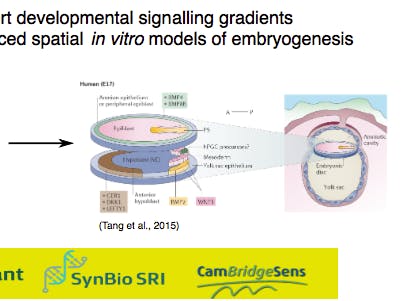Here we aim to develop biological tools for investigating spatial effects of signalling on cell fate and patterning. To do so, the physical environment of cells will be constrained to mimic a variety of informative geometries using 3D printing or micropatterning technologies. Mammalian cells with fluorescent reporters (“sensor” cells) will be monitored in real time, and used to report developmental signalling gradients secreted by a second population of synthetically constructed cells with inducible expression of signalling molecules (“controller” cells), allowing appropriate statistics to be automatically generated. This will serve as a platform for developing affordable in vitro models of embryo development with spatio-temporal resolution of cell fate decisions.
ProposalThe problemEmbryogenesis is a tightly controlled dynamic system highly regulated at the spatial and temporal levels. Individual cells within the developing embryo respond to a myriad of signals from embryonic and extraembryonic tissues, to undertake a series of sequential cell fate decisions ultimately forming a complete and organised individual. Understanding how individual cells integrate these multiple (spatial) cues to make the appropriate cell fate decision remains an open challenge. Typically, the study of embryogenesis makes use of ex vivo culture, which may be difficult in humans. Alternatively, in vitroculture systems can be used, but may not be appropriate for investigating combinatorial signalling. Both approaches require the costly use of cytokines and growth factors. Here we aim to control the 2D/3D environment by imposing spatial constraints to mimic a variety of in vivo geometries, and use synthetic “controller” cells to deliver appropriate developmental cues to direct the cell fate of “sensor” cells that can be monitored in real time. Our approach will prove a reproducible platform for the advanced in vitro investigation of cell fate decision making.
Biological systemsInvestigating the decision making process of mammalian embryogenesis remains a challenge, particularly in humans where embryos may be impossible to acquire over key developmental stages. Instead, studies of cell fate decision making and development often rely on differentiation of pluripotent stem cells, which may prove costly. Here we aim to develop a synthetic in vitro approach for investigating spatial effects of signalling on cell fate decision of human pluripotent stem cells that more naturally reflects the processes encountered in vivo.
As a proof-of-principle, we will use Nodal signalling, a key component required to establish the anterior-posterior axes of the developing embryo. We will use mammalian pluripotent stem cells that inducibly express NODAL (“controller” cells), to deliver a developmental signal to a second population of pluripotent stem cells that contain Nodal-responsive fluorescent reporters (Brachyury::GFP; “sensor” cells; Figure 1(c)). By additionally constraining the 2D/3D environment, we will be able to simultaneously investigate the impact of Nodal signalling on “sensor” cells over a range of distances and geometries, that can be monitored in real time. This proof-of-principle control of the spatial signalling environment will form the basis for more affordable in vitro models that can be used to investigate spatial elements of early embryogenesis.
Hardware design goalsWe will first design the 2D/3D environment of cells to mimic a range of geometries encountered in vivo (Figure 1(a, b)), as well as novel geometries that may not exist in nature but may prove informative. This will be achieved using either 3D printing technologies or micropatterning approaches. Two populations of cells will be constructed: (i) synthetically constructed “controller” cells that inducibly express Nodal will be used as basis for delivering developmental signals; (ii) a second population of cells with Nodal responsive GFP reporters (Brachyury::GFP) will be used as a readout indicating a response to Nodal. Fluorescence will be monitored in real time, and appropriate statistics will be generated e.g., plots of fluorescence as a function of distance from “controller” cells and geometry.
Project implementationTarget cells with Brachyury::GFP-reporters are under construction. FW will construct synthetic “controller” cells that inducibly express Nodal. GB and CP will develop capacity for real time monitoring of fluorescence and statistical analyses. CP and FW will design geometry for 3D printed/micropatterned environments. FW and CP will test the system. All will perform final analysis of data.
Outcomes- Proof-of-principle of using one population of ESCs (synthetic “controller” cells) to direct the fate of a second population of ESCs (“sensor” cells) that can be monitored in real time. Work in progress.
- The ability to deliver appropriate signals via “controller” cells will partially mitigate the need for expensive cytokines and growth factors. Construct Brachyury::GFP-reporters and inducible Nodal ESC. Work in progress.
- Demonstrable use of 3D printing or micropatterning to control spatial aspects of signalling important during early embryogenesis. Initial estimates of commercial micropatterning (£600) were to high, initiated a collaboration with Huang group in the department of Engineering to use modified 3D printer to spatially control cells. Preliminary results suggest viability of stem cells following 3D printing.
3D printing or micropatterning and cytokines (~£700)
ReferencesWarmflash et al. (2014). Nature Methods, 11 (8), 847-854.
Blin et al. (2017). BioRχiv, doi: 10.1101/138354
Biomaker Challenge 2017: Team 36
 Jim Haseloff
Jim Haseloff




Comments
Please log in or sign up to comment.